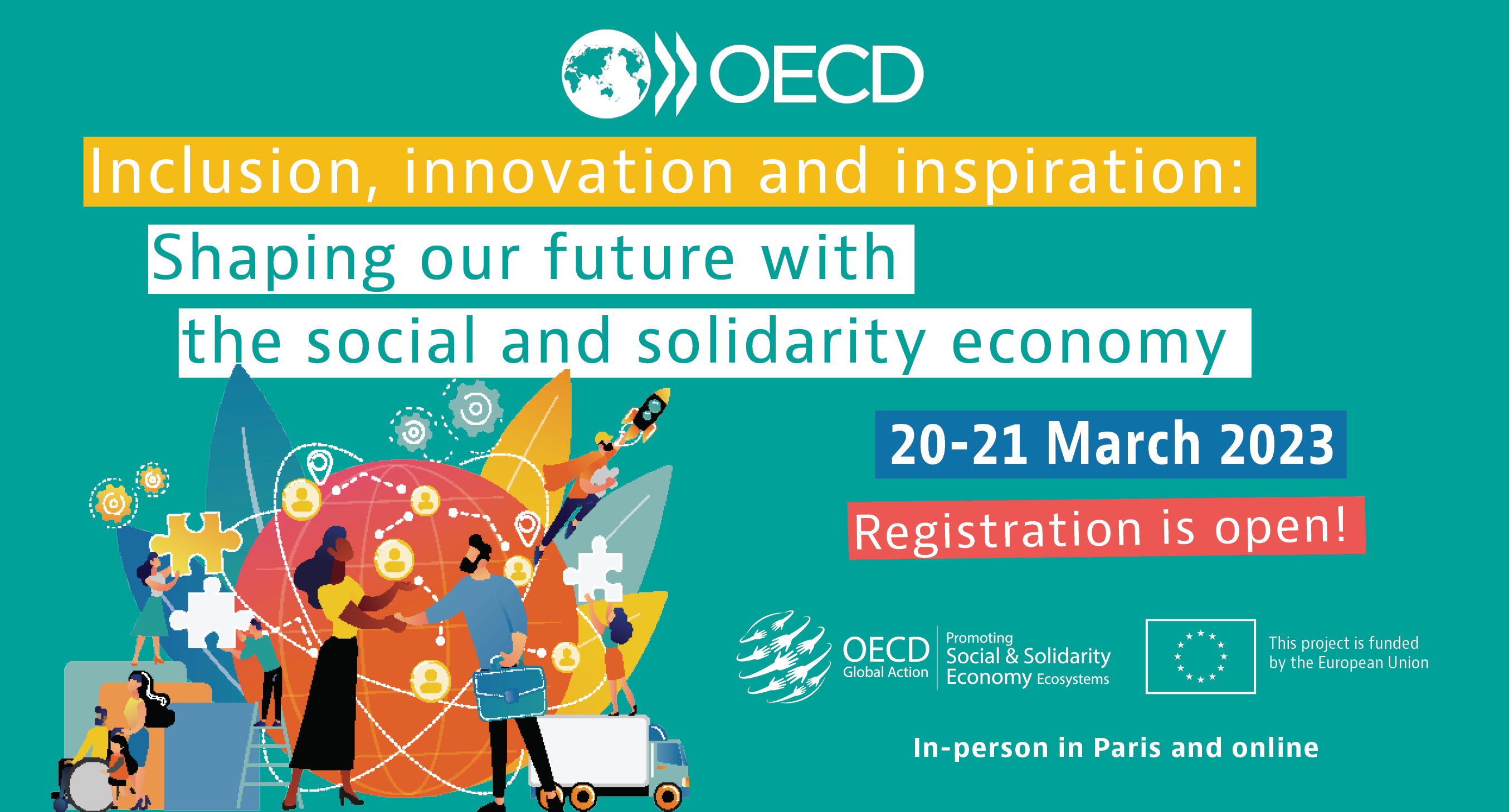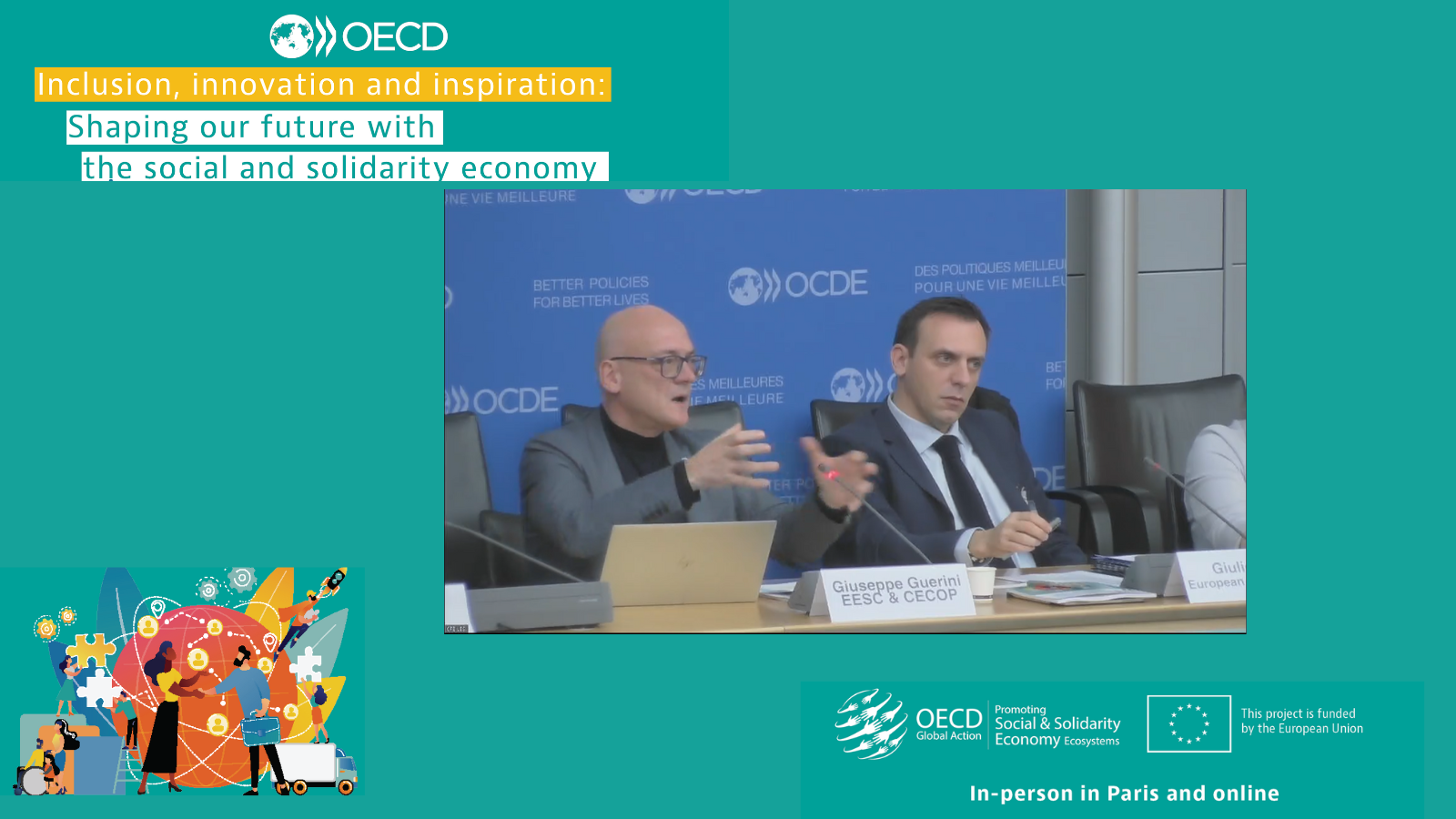
On the 20 and 21 of March 2023, CECOP president Giuseppe Guerini attended the OECD conference “Inspiration, innovation and inclusion: Shaping our future with the social and solidarity economy”. The event regrouped policy makers, experts, and practitioners to discuss the transformative power of the social economy in creating innovative business models that build social cohesion and resilience.
Guerini intervened during the roundtable “Visible, valuable and visionary: Taking stock of the social economy’s impact” to share lessons learned from the good practices in CECOP’s network on social impact measurement.
While there is not a standardised way to measure cooperative social impact, cooperatives have always measured important social aspects of their work, such as mutuality, workers’ participation in governance, and their contribution to local communities.
In many countries, cooperatives have been measuring their social impact through their cooperative audit (mandatory by cooperative legislation in most EU countries).
In our publication ‘Lasting Impact’ we present two main examples of impact measurement tools originated from the experience of cooperatives in Italy and Spain.
Since the 1990s, Italian social cooperatives developed the habit of annually publishing a bilancio sociale (social audit) on their own will, in order to better demonstrate their specific contribution to the social missions they had set to achieve, going through the exercise of assessing the non-financial dimension of their activities. In 2020, it became a national obligation for social cooperatives In Italy to submit their bilancio sociale annually.
Based on existing European practices three main lessons can be drawn:
- Measuring social impact provides visibility for cooperatives at the public and political level, thus encouraging the adaptation of legislations and policies in favour of cooperatives.
In Spain, the balance social, is a social impact measurement tool developed by the Catalan Network of Solidarity Economy XES that uses indicators that correlate with 6 out of the 17 SDGs. It translates the UN’s global goals into a local dimension of action. By doing so, the balance social plays an important role as a driving force for the social economy at a local level. Spain is a country with a very strong cooperative movement, but impact measurement helps to keep attention on the cooperatives.
- The tools and approach to measure social impact should be user friendly and tailored using suitable indicators to better capture the added value of cooperatives.
In Italy, although the official guidance sets a relatively strict series of sections that must be covered in each bilancio sociale, it does not mandate the use of a specific methodology or data collection tool. It is therefore the role of cooperative federations to step in and provide their members with tools and guidance that will allow them to gather information in a way that will be consistent across time and geography. And this is what the Italian federation Confcooperative Federsolidarietà did by developing a national platform to guide social cooperatives. Official guidelines provide a detailed list of topics and sections that must be covered in the report but does not specify exact indicators.
It is essential that social reporting is used to interpret the generated data through suitable indicators, to capture and share the added value generated by its activities with the communities of reference. Additionally, it is important that social impact reporting and evaluation remains an easy process in order to not overwhelm cooperatives and drive resources away from their primary activity.
- Measuring social impact allows cooperatives to self-reflect, assess their strengths and shortcomings, and to continuously improve themselves.
Over the last years, social impact measurement was mainly looked as a tool for financing purposes to convince and satisfy investors. This is something we have been listening for a while from some EU networks working on microfinance, social impact investment, but also the EU Commission.
Existing cooperatives measuring tools also demonstrate that social impact measurement can be used for other purposes, such as the positive social and even green impact.
In this respect, it is also an opportunity for cooperatives to revise and analyse their impact and see where they can improve.
CECOP welcomes the OECD’s Policy Guide on Social Impact Measurement for the Social and Solidarity Economy as a tool to accelerate the support of social impact measurement in policy-by-policy makers.
There is a need for public authorities to contribute more to supporting and mainstreaming social impact measurements.
However, in respect of the ‘lessons learned’ mentioned above, it is important to stress that the design of a tool for social impact measurement should take place in collaboration with the social economy actors that have experience in implementing social impact measurement.
We are particularly happy to see that the OECD recommends close partnerships in developing the tools, frameworks, and resources necessary to provide the right policies, capacities, and guidance to social economy actors in measuring social impact. The policy guide also mentions CECOP’s report “Lasting Impact” and its toolkit on “Measuring the Social Impact of Industrial and Service Cooperatives in Europe” as a good practice in having a bottom-up approach to co-building guiding resources.
As reported in the ‘pitfalls to avoid session’ of the guide we are glad to see that the guide recommends to never use social impact evidence to punish “underperforming” social economy actors. Measuring social impact cannot become an excuse to commodify it. This should be particularly clear if any ring-fencing practice is established.
The guide also underpins the importance to support the use of public procurement as a tool to effectively steer the social economy and further development of social impact measurement.
As mentioned by CECOP’s president Giuseppe Guerini at the OECD conference:
“In EU, public procurement accounts for 14% of the EU's GDP and amounts to 2 trillion Euro per year. This is an enormous force for shaping the future of social economies. To spend public resources better, we must continue to be responsibly oriented towards social inclusion policies. An important point to raise is the need to systematically integrate social impact criteria into public procurement.”

The OECD has published a full report on the event which you can consult by following this link.







 Employment & Social Inclusion
Employment & Social Inclusion  Sustainable Growth
Sustainable Growth 

